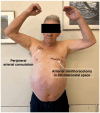Early Outcomes in Severely Obese Patients Undergoing Sternum-Sparing Minimally Invasive Multivessel Artery Bypass Grafting Using Total Coronary Revascularization via Left Anterior Mini-Thoracotomy
- PMID: 40283376
- PMCID: PMC12028217
- DOI: 10.3390/jcm14082545
Early Outcomes in Severely Obese Patients Undergoing Sternum-Sparing Minimally Invasive Multivessel Artery Bypass Grafting Using Total Coronary Revascularization via Left Anterior Mini-Thoracotomy
Abstract
Background/Objectives: Severe obesity significantly increases the risk of complications following full sternotomy in coronary artery bypass grafting (CABG). However, these patients are frequently excluded from less invasive, sternum-sparing surgical alternatives. This study aimed to assess the safety and practicality of a newly developed technique-Total Coronary Revascularization via left Anterior miniThoracotomy (TCRAT)-that avoids sternotomy in patients with severe obesity requiring multivessel CABG. Methods: From November 2019 to May 2024, a total of 502 non-emergency patients with multivessel coronary artery disease underwent CABG through a left anterior minithoracotomy using cardiopulmonary bypass (CPB) and cardioplegic arrest. Of these, 43 patients with a body mass index (BMI) exceeding 35.0 kg/m2 were classified as severely obese and included for subgroup analysis. Their outcomes were compared to those of the remaining 459 patients with BMI below 35.0 kg/m2. Key intraoperative variables-such as total operative time, CPB duration, aortic cross-clamp time, and graft strategy-were evaluated. Postoperative outcomes, such as the incidence of major adverse cardiac and cerebrovascular events, minor complications, and length of stay in ICU and hospital, were also analyzed. Results: Severely obese patients exhibited a longer total operation time (353.5 ± 83.6 min vs. 320.4 ± 73.4 min, p < 0.05). In contrast, no statistical differences were observed in aortic cross-clamp time (97.9 ± 27.6 min vs. 95.6 ± 33.0 min; p = 0.307) or CPB time (163.3 ± 35.0 min vs. 155.0 ± 42.9 min; p = 0.078). Both groups received a similar number of distal anastomoses (3.1 ± 0.7 vs. 3.0 ± 0.8; p = 0.194), and the frequency of total arterial revascularization was comparable (34.9% vs. 40.0%; p = 0.268). There were no differences between the groups in major complications, including hospital mortality (2.3% vs. 1.1%, p = 0.227), stroke (0.0% vs. 0.6% p = 0.300), or need for re-revascularization (0.0% vs. 1.1%, p = 0.248). Similarly, minor complications, such as wound healing issues (2.3% vs. 1.1%, p = 0.233) and revisions for bleeding (4.6% vs. 7.2%, p = 0.276), were comparable between groups. ICU stay (2.7 ± 4.5 days vs. 2.2 ± 4.0 days; p = 0.225) and total hospital stay (12.3 ± 9.6 days vs. 10.8 ± 8.6 days; p = 0.142) showed no meaningful differences. Conclusions: TCRAT can be performed safely and effectively in severely obese patients, providing a feasible minimally invasive option for complete coronary revascularization in cases of multivessel disease. This approach eliminates the complications associated with sternotomy, making it a valuable surgical alternative for this high-risk patient group.
Keywords: CABG; TCRAT; minimally invasive cardiac surgery; obesity; surgical outcomes.
Conflict of interest statement
The authors declare no conflicts of interest.
Figures
Similar articles
-
Renal Outcome in Patients Undergoing Minimally Invasive Total Coronary Revascularization via Anterior Minithoracotomy Compared to Full Median Sternotomy Coronary Artery Bypass Grafting.J Clin Med. 2024 Sep 12;13(18):5418. doi: 10.3390/jcm13185418. J Clin Med. 2024. PMID: 39336904 Free PMC article.
-
Multivessel Arterial Revascularization via Left Anterior Thoracotomy.Semin Thorac Cardiovasc Surg. 2020 Winter;32(4):655-662. doi: 10.1053/j.semtcvs.2020.02.032. Epub 2020 Feb 28. Semin Thorac Cardiovasc Surg. 2020. PMID: 32114114
-
Sternum-sparing multivessel coronary surgery as a routine procedure: Midterm results of total coronary revascularization via left anterior thoracotomy.JTCVS Tech. 2024 Jun 3;26:52-60. doi: 10.1016/j.xjtc.2024.05.018. eCollection 2024 Aug. JTCVS Tech. 2024. PMID: 39156523 Free PMC article.
-
Stroke Rates Following Surgical Versus Percutaneous Coronary Revascularization.J Am Coll Cardiol. 2018 Jul 24;72(4):386-398. doi: 10.1016/j.jacc.2018.04.071. J Am Coll Cardiol. 2018. PMID: 30025574
-
Minimally Invasive Multivessel Coronary Surgery and Hybrid Coronary Revascularization: Can We Routinely Achieve Less Invasive Coronary Surgery?Methodist Debakey Cardiovasc J. 2016 Jan-Mar;12(1):14-9. doi: 10.14797/mdcj-12-1-14. Methodist Debakey Cardiovasc J. 2016. PMID: 27127557 Free PMC article. Review.
References
-
- Babliak O., Demianenko V., Melnyk Y., Revenko K., Pidgayna L., Stohov O. Complete Coronary Revascularization via Left Anterior Thoracotomy. Innovations. 2019;14:330–341. - PubMed
LinkOut - more resources
Full Text Sources


